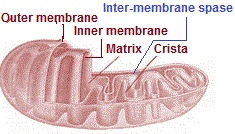The Mitochondria
Mitochondria, unless specifically stained, are not easily visible under the microscope. The number of mitochondria per cell is variable depending on the physiological activity of the cells. In terms of shape and size also, considerable degree of variability is observed.
Typically it is sausage-shaped or cylindrical having a diameter of 0.2-1.0μm (average 0.5μm) and length 1.0-4.1μm.
Every mitochondrion is a double membrane-bound structure with the outer membrane and the inner membrane dividing its lumen distinctly into two aqueous compartments as follows:
The inner compartment is filled with a dense homogeneous substance called the matrix.
The outer membrane forms the continuous limiting boundary of the organelle.

The inner membrane forms a number of infoldings called the cristae towards the matrix. The cristae increase the surface area. The two membranes have their own specific enzymes associated with the mitochondrial function.
Mitochondria are the sites of aerobic respiration. Mitochondria produce cellular energy in the form of ATP. Mitochondria are power houses of the cell.
The matrix also possesses single circular DNA molecule, a few RNA molecules, ribosomes (70S) and the components required for the synthesis of proteins.
The mitochondria divide by fission.
Importance and Role of mitochondria in the cell
Mitochondria have roles in energy production, providing metabolites for building macromolecules and aiding in differentiation, apoptosis and cell cycle
The mitochondria are organelles that use oxygen and nutrients to generate energy and heat to maintain a stable body temperature
Role in energy production
The outer mitochondrial membrane is freely permeable to small molecules and contains special channels capable of transporting large molecules. In contrast, the inner membrane is far less permeable, allowing only very small molecules to cross into the gel-like matrix that makes up the organelle’s central mass. The matrix contains the deoxyribonucleic acid (DNA) of the mitochondrial genome and the enzymes of the tricarboxylic acid (TCA) cycle which metabolizes nutrients into by-products the mitochondrion can use for energy production.
The processes that convert these by-products into energy occur primarily on the inner membrane, which is bent into folds known as cristae that house the protein components of the main energy-generating system of cells, the ETC.
The ETC uses a series of oxidation-reduction reactions to move electrons from one protein component to the next, ultimately producing free energy that is harnessed to drive the phosphorylation of ADP (adenosine diphosphate) to ATP.
This process is known as chemiosmotic coupling of oxidative phosphorylation, powers nearly all cellular activities, including those that generate muscle movement and fuel brain functions.
Some diseases are caused by mitochondria as follows:
Mitochondrial disease can cause a vast array of health concerns, including fatigue, weakness, metabolic strokes, seizures, cardiomyopathy, arrhythmias, developmental or cognitive disabilities, diabetes mellitus, impairment of hearing, vision, growth, liver, gastrointestinal, or kidney function etc.
